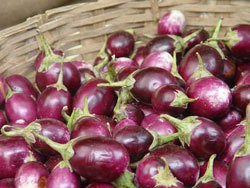Freezing eggplants will severely alter their texture, but is still useful for some recipes. Harvest eggplants before seeds become mature and when color is uniformly dark. Skins should be smooth, glossy and free of cuts and scars. Smaller eggplants are more likely to be tender. The eggplant should feel firm, and heavy for its size. Eggplants tend to have a short shelf life when fresh, so plan to process as quickly as possible after harvesting.
Wash, peel and dice to cut up into 1/2-inch thick slices. To maintain color, prepare only one eggplant at a time. The flesh turns color quickly when exposed to air. You can also add 1/4 cup of lemon juice or 1 tablespoon ascorbic acid to 5 cups water during blanching.
Water-blanch for 4 to 5 minutes (up to 1 pound at a time) in 1 gallon of boiling water containing 1/4 cup lemon juice. Cool promptly and drain.
Dry Pack-Transfer cool, blanched slices directly into suitable containers, leaving 1/2-inch of headspace. Seal and freeze.
Freezer containers should be moisture and vapor resistant and should not be prone to cracking or breaking at low temperatures. Containers should provide protection against absorbing flavors or odors and should be easy to label. Suitable packaging for freezing eggplant includes freezer-grade plastic bags, rigid plastic containers, glass containers and heavy duty aluminum foil.
6 to 8 months at 0ºF.
Add frozen eggplant directly to dishes while cooking.
To freeze eggplant for frying, separate slices with wax paper or plastic wrap during freezing.
Store fresh eggplant in a perforated plastic bag for 3 to 4 days.

Add your voice! Click below to comment. ThriftyFun is powered by your wisdom!